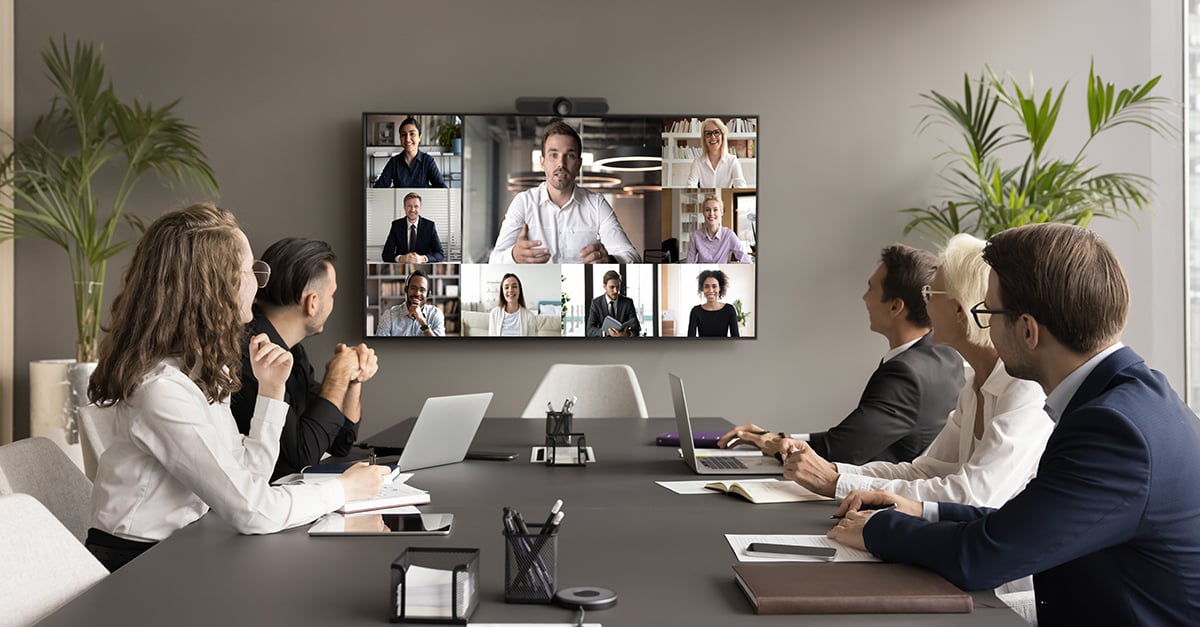Video conferencing platforms have become a staple in the modern workplace as organizations are...
Vidiquette: Video Conferencing Etiquette
Video has become a greater part of our daily work lives, and COVID-19 brought its use to the forefront. Video conferences lack universally accepted rules of engagement, unlike text messaging and email. As visual communication increases, video conferencing etiquette is developing more and more. Since being on video can sometimes be uncomfortable for people that are new to it, a little guidance into vidiquette can provide much needed comfort! There are a few key fundamentals to follow that will make video conferences a more positive and comfortable experience for not only you, but your colleagues.

- While on video calls remember you are on camera. Some people who have been doing audio calls for years have come accustomed to multitasking during meetings. When on video, everything you do can actually be seen. It sounds obvious but can easily be forgotten! Looking at your computer display, typing on a keyboard or even carrying on IM conversations are some of the many multitasks that can be equivalent to speaking too loudly on your phone in public. Video conferences can be much more interpersonal and interactive. Attentiveness, non-verbal cues and facial expressions matter. Behave the way you would in a live meeting!
- Looking at the camera is a key value of video conferencing that can lead to a stronger video conference. One of the most critical contributions to creditably is making eye contact. After you use the picture-in-picture to make sure the view is what it should be, turn it off so you don’t get distracted by seeing yourself. Be courteous if you are looking at a video monitor and computer monitor as it can be distracting to others when you are presenting.
- Having the volume level set correctly is also critical for making sure you have a successful video conference. You must ensure that when you connect to the conference, your voice is clear and audible. With personal devices, this means testing the microphone you’ll be using. This helps avoid the awkward video interviews where you end up having to use gestures rather than words because of audio challenges. If in a conference room, keep in mind that those who were in the conference before you may have lowered, raised or muted the volume for their participants. A rule of thumb is to set the volume mid-level or slightly higher which will enable you to clearly hear and be heard during your video call.
- If you are in a conference call with three or more parties, mute your audio when you aren’t speaking. Polycom NoiseBlock technology mutes non-verbal background noises but some noises won’t be distinguished between relevant and irrelevant sounds like barking and the vacuum. Perhaps let your fur baby enjoy some fresh air during your meeting! When you want to say something simply press or click the “unmute” button and make your point, then when you are done you can return to mute mode. Muting can be appreciated when calling into a conference from a cell phone, where signals can be prone to cause static and background noises.
- Before starting the call, check to see how you will appear to those on the other end of the video conference. This practice is called polishing your image. The acronym “LEAP”, which stands for Light, Environment, Attire and Portrait, can be a nifty tool helping to set you up for success.
- Light: Make sure you have enough of it in front of you and not behind you so you can truly be seen. Also, make sure not to slouch, you want to be clearly visible in the screen.
- Environment: Make sure to pay attention to the environment around you and that you don’t have any distractions in the background.
- Attire: Your attire matters! Try to stay away from pinstripes, complicated patterns and checkered designs. You want your colleagues to be focused on your words and ideas, not so much the hypnotizing pattern on your shirt.
- Portrait: Check to make sure you are clearly visible in the frame with the right portrait. You don’t want to be focused on one part of your face. This is important when you are using personal devices such as laptops. Raise your laptop or webcam to give you a more direct view. Group video systems tend to have better lighting and camera angels, but make sure you are clearly visible on you and your colleague’s device to help ensure the best human connection.
- Making sure to have your content ready is another key fundamental to a good video call or conference. If you are planning to share content during the call, make sure you have your documents and or slides ready to share so you aren’t asking, “can you see my content yet.” This can be very frustrating! Be prepared in order to save you and your colleagues from lost time and frustration. Remember that when you share content to be conscious of what you are sharing. This means choosing wisely between modes such as sharing a specific document, an application or your entire desktop. Let’s steer clear of any embarrassment that you will get heckled about for months!
- Once a video call or conference has started make sure you avoid unnecessary adjustments. Certain adjustments may be necessary in response to environmental changes. However, adjusting your video too much may cause distractions and disruptive behaviors for the far end participants or the person talking. Do a test run first to make sure everything is in check!
- If you wouldn’t do it in person don’t do it on video! There may be many common challenges you can endure from being in public to even sitting at your kitchen table at home when on a video call. An example of this can be chewing, not to say that you can’t have a “working lunch” during a video meeting, but your microphone right by your mouth can be effective at picking up noises like chewing. When snacking, be attentive to the mute button. Nobody wants to hear you devour your afternoon chips and salsa!
- If you are a remote worker, use the “what would I do in the office” test. Would you hide in your cubicle and not attend meetings with everyone else? An “off” day shouldn’t keep you off video. If you opt out of the video aspect and do audio only the power of video conferencing gets lost. There are expectations when joining a video meeting from a remote site. If you are on a vacation, turning off your video and going on audio can make the experience better for everyone involved. No need to make all your co-workers jealous! Video can be more demanding on bandwidth, so if you have to turn off your video in certain situations with poor connectivity, keeping your audio on will allow you to be heard while still being able to see others and content.
- Home-based workers can sometimes have domestic interruptions, which can end up impacting your video meeting and the image you present to others. If you wouldn’t want your personal life being shared at work, you should avoid having it displayed behind you in your home office. Consider temporarily removing any wall hangings that may appear on camera that wouldn’t be appropriate in the work office. Loved ones dropping by the office on occasion can be very nice, but every day can be a distraction. You can eliminate the distractions with a simple cue card (“Do Not Disturb”) taped to the outside of your at home work office. This can help set a professional tone. If you have pets remember to let them out to play before the meeting or presentation. Make sure your family knows how to support you; this can come in big when having to use the same internet as all the other devices in your home. Things to avoid include: large downloads, streaming, and online gaming.
- When joining a video conference, remember that public environments are public and the person sitting next to you does not want to know your business. Sorry, but the fella’ behind you at Starbucks doesn’t care about your marketing budget! Use a headset and make sure your voice is at a conversational level. When sharing sensitive information remember to be thoughtful and think about what you are sharing before you share. Always be prepared to go audio only to preserve quality. Keep yourself on mute when at airports or busy places unless you are speaking. Try to stay put while on video calls, it makes it easier to focus on you instead of all the background distractions. Some video conferencing programs allow you to blur the background or completely change it to an image of your choosing.
With video conferencing become more heavily used with an increased number of remote workers it is important to have some guidelines to follow. Video conferencing can be a powerful tool which is the next best thing to being present in person. It can help businesses stay productive and employees connected to one another. It’s time we embrace this awesome technology. However, to get the most out of it while providing a positive experience for all involved, we must follow proper vidiquette!
Want to learn more about video conferencing solutions and best practices? Reach out to our audio visual experts below.



